Beef Stew Recipe with Carrots & Potatoes
This post may contain affiliate links. Read my full disclosure policy.
This classic French beef stew is the ultimate comfort food. Slow-cooked in a rich wine-based broth, the meat becomes meltingly tender and enveloped in a deeply flavorful sauce—perfect for chilly nights.
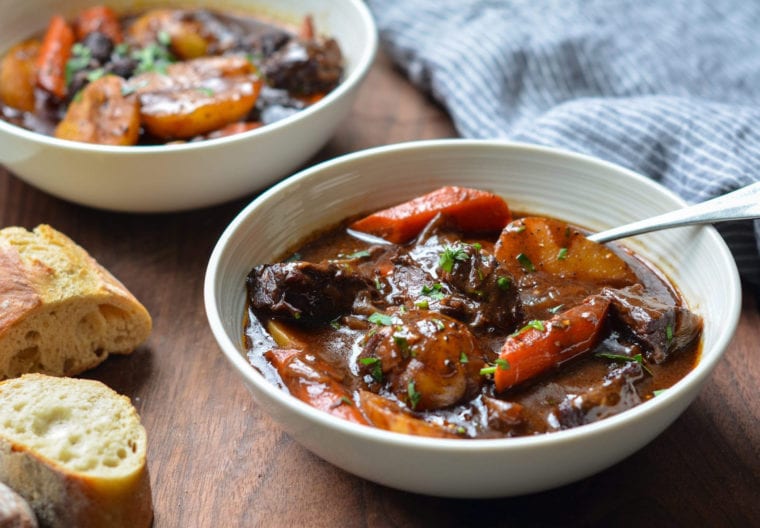
With thousands of 5-star reviews, this classic French beef stew is the most popular recipe on my site—and for good reason! It’s incredibly delicious and the ultimate cold weather comfort food. Pieces of well-marbled beef are seared in a hot pan, then gently braised with garlic and onions in a rich wine-based broth. After a few hours, the meat becomes fork tender and enveloped in a deeply flavorful sauce. While it takes some time to make, this stew is mostly hands-off. Go ahead and make it a day or two ahead of time—the flavor only gets better as it sits.
When it comes to serving, this beef stew recipe is incredibly versatile. I love pairing it with crusty bread or popovers to soak up all that rich, unctuous sauce. It’s also delicious served over mashed potatoes, buttered egg noodles, or creamy polenta if you want to make it even heartier. For a lighter touch, you can balance out the richness by serving it alongside a simple green salad.
“This recipe is SERIOUSLY EPIC! Hands down, the best beef stew recipe I have ever made. Thank you. 🙏”
What You’ll Need To Make Beef Stew
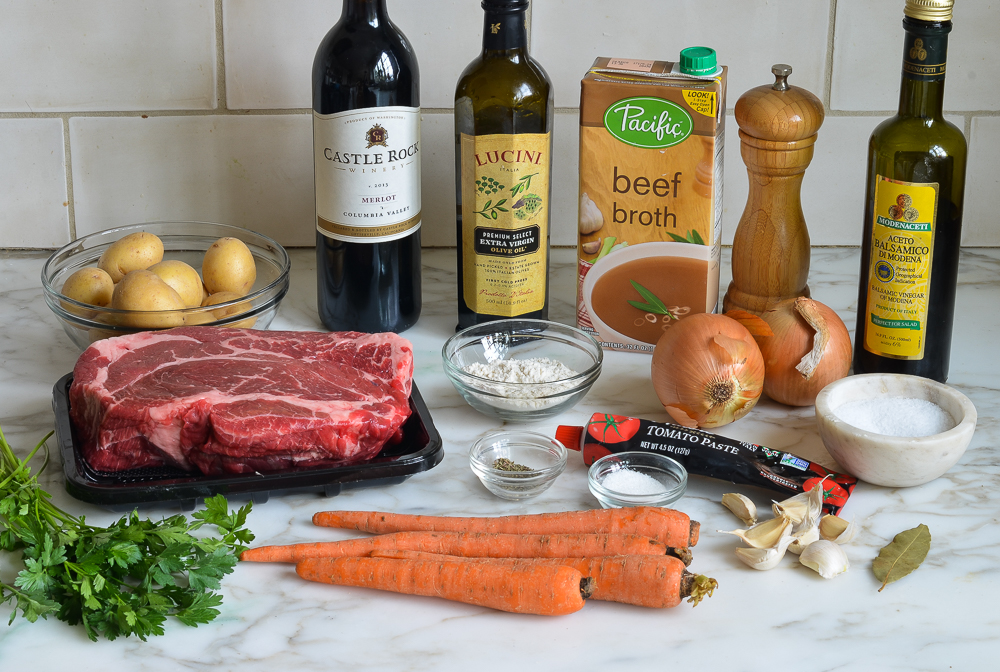
- Boneless beef chuck: The key to tender, flavorful stew. Look for chuck roast with a good amount of marbling, or white veins of fat running through it. Avoid generic “stew meat,” especially if it looks lean. I guarantee you it won’t become tender, no matter how long you cook it.
- Olive oil: Used for browning the beef and sautéing the vegetables.
- Yellow onions and garlic: Adds sweetness, depth, and savory aroma to the stew as they cook.
- Balsamic vinegar: Adds acidity and depth, balancing the richness of the stew.
- Tomato paste: Thickens the stew and imparts a rich tomato flavor.
- All-purpose flour: Coats the beef and acts as a thickening agent for the stew. When added to the beef before the liquid, it mixes with the juices from the meat and creates a base for the sauce. As the stew simmers, the flour helps thicken the broth, turning it into a rich, velvety sauce that clings to the meat and vegetables.
- Dry red wine: Adds bold flavor and forms the base of the stew along with the broth and water. Use any dry red wine like Pinot Noir, Merlot, or Cabernet Sauvignon that is inexpensive but good enough to drink.
- Beef broth and water: Forms the liquid base along with the wine.
- Bay leaf and dried thyme: Classic aromatics that infuse earthy flavors.
- Sugar: Balances the acidity from the wine and tomato paste.
- Carrots: Adds natural sweetness and texture.
- White boiling potatoes (baby Yukons): These small potatoes soak up the rich broth and add heartiness.
- Fresh parsley: A fresh garnish that brightens the stew.
- Jump to the printable recipe for precise measurements
Step-by-Step Instructions
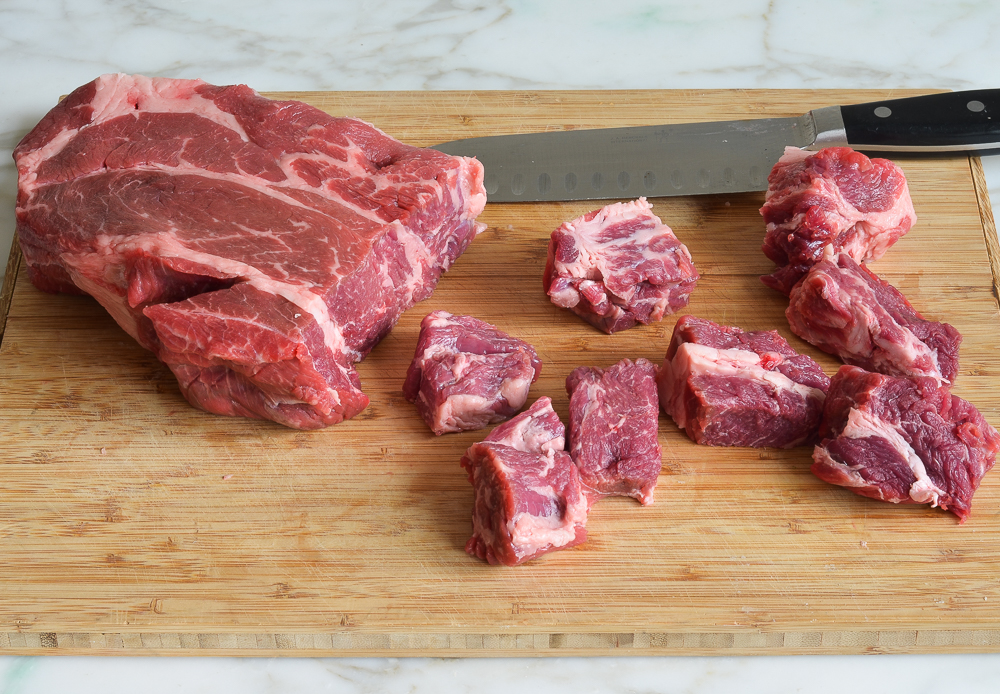
Begin by removing any large chunks of fat that are easy to get to (like the one my knife is pointing to below), but don’t overdo it with the trimming, as the fat helps make the beef tender.
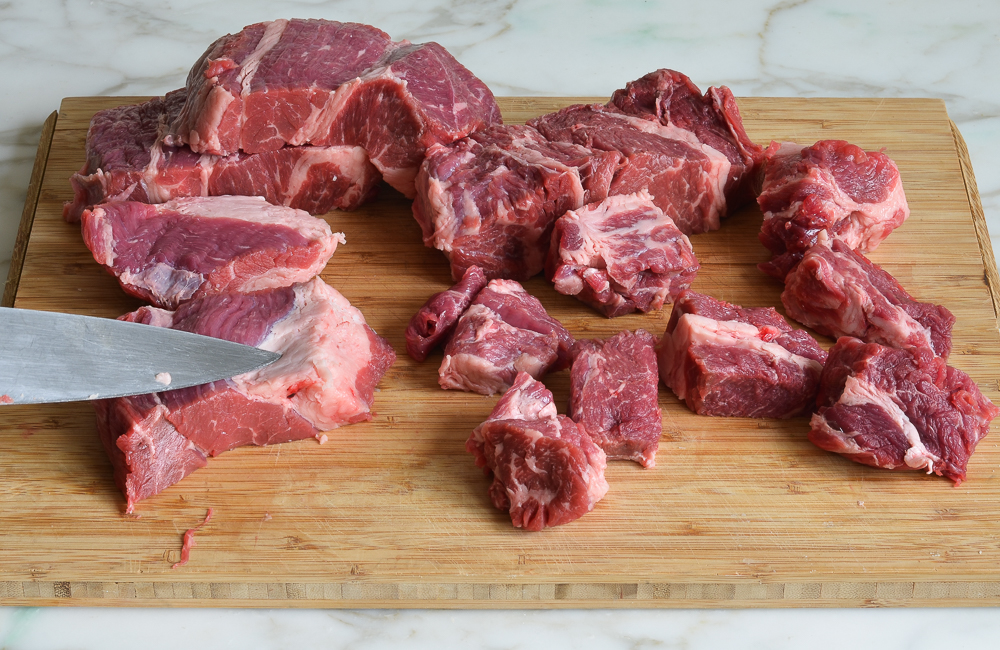
Next, season the meat generously with salt and pepper.
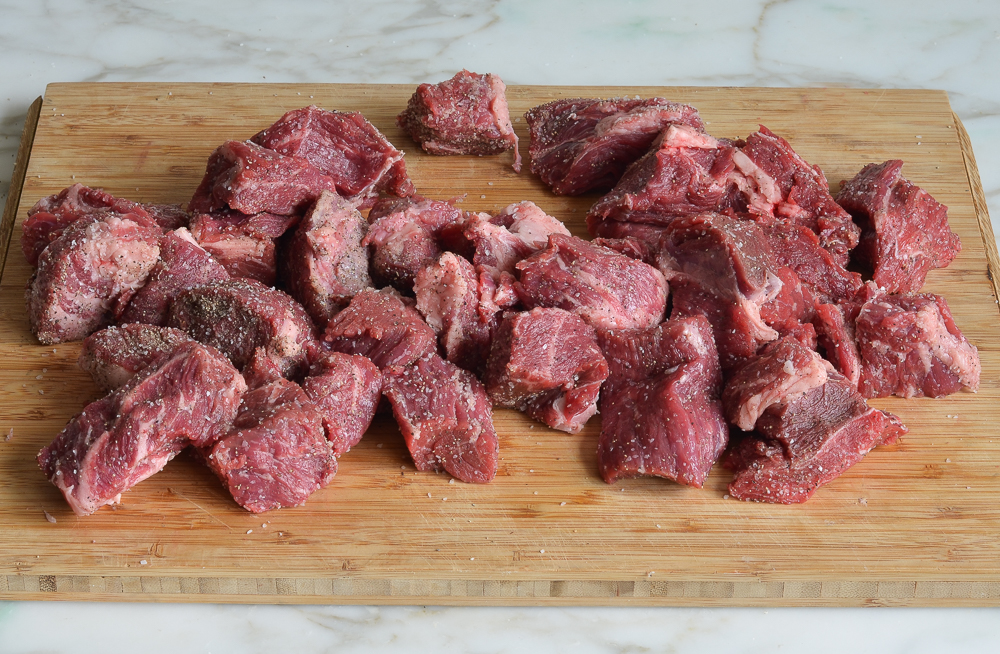
Heat a bit of oil in a Dutch oven or large pot and brown the meat in batches.
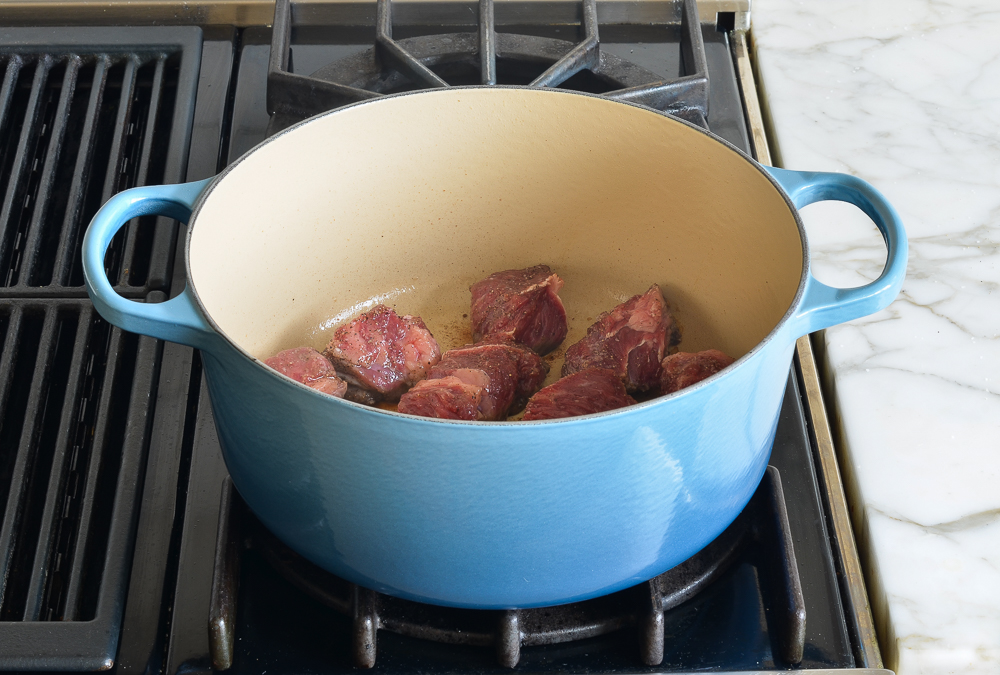
This step is a bit time-consuming but browning the meat adds depth and dimension to the stew. (Note: it’s important not to crowd the pan—if you try to brown all the meat at once, it will steam instead of sear and you won’t get all that lovely color and flavor.)
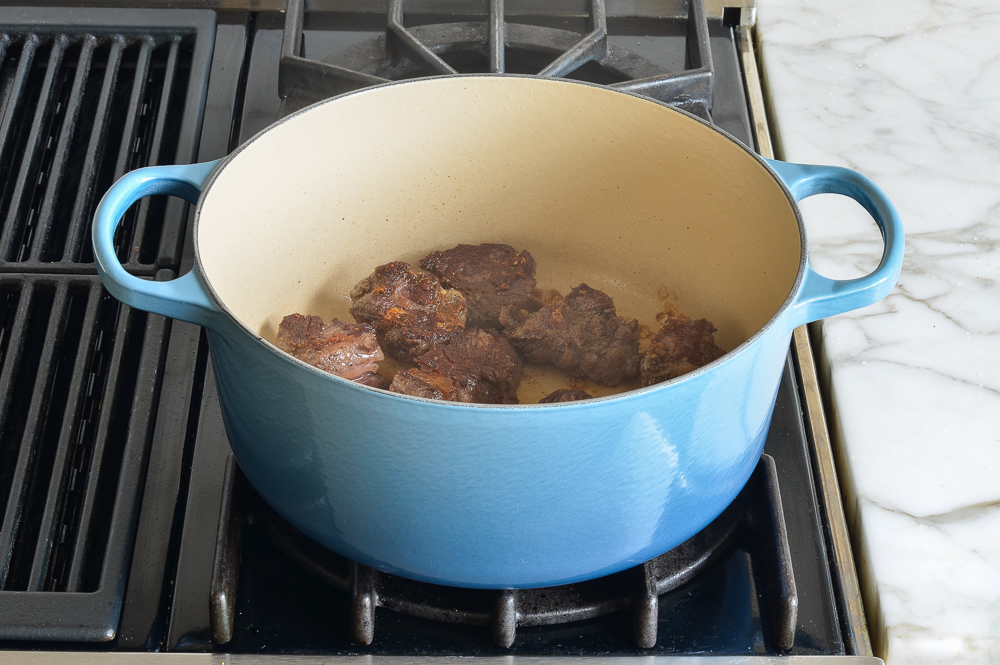
Remove the meat and add the onions, garlic, and balsamic vinegar to the pan. The vinegar will loosen all the brown bits from the bottom of the pan and add flavor.
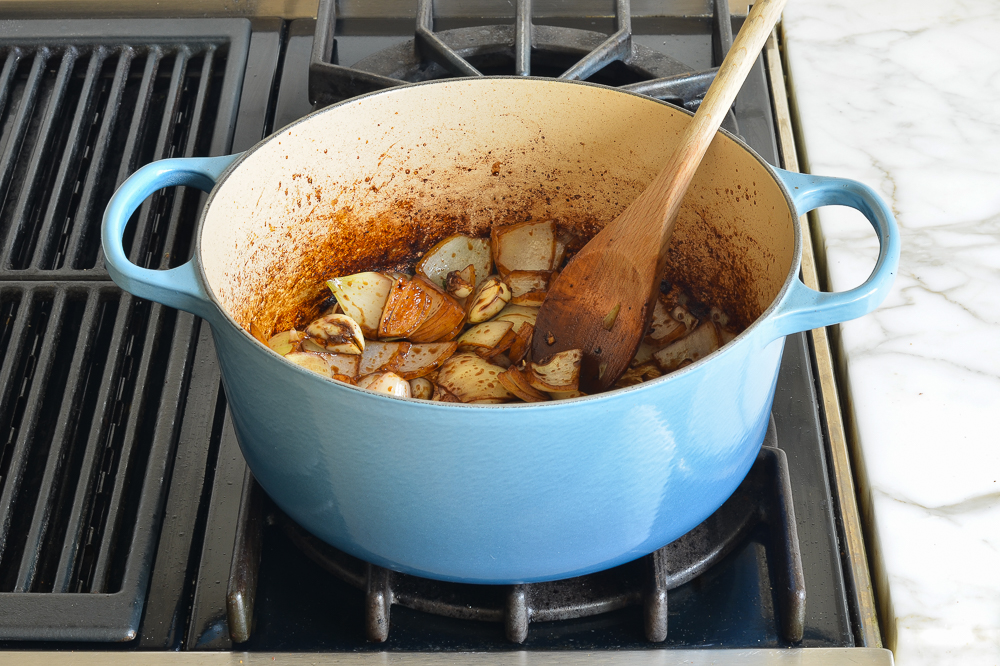
Cook until the vegetables are softened, then add the tomato paste and cook for a minute more.
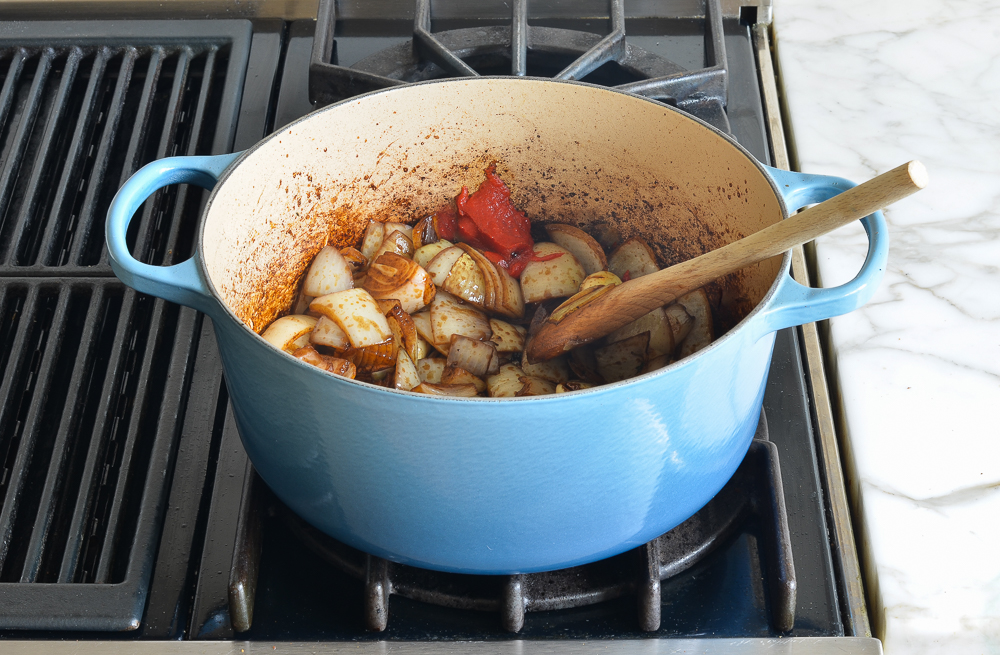
Add the beef back into the pan and sprinkle with the flour.
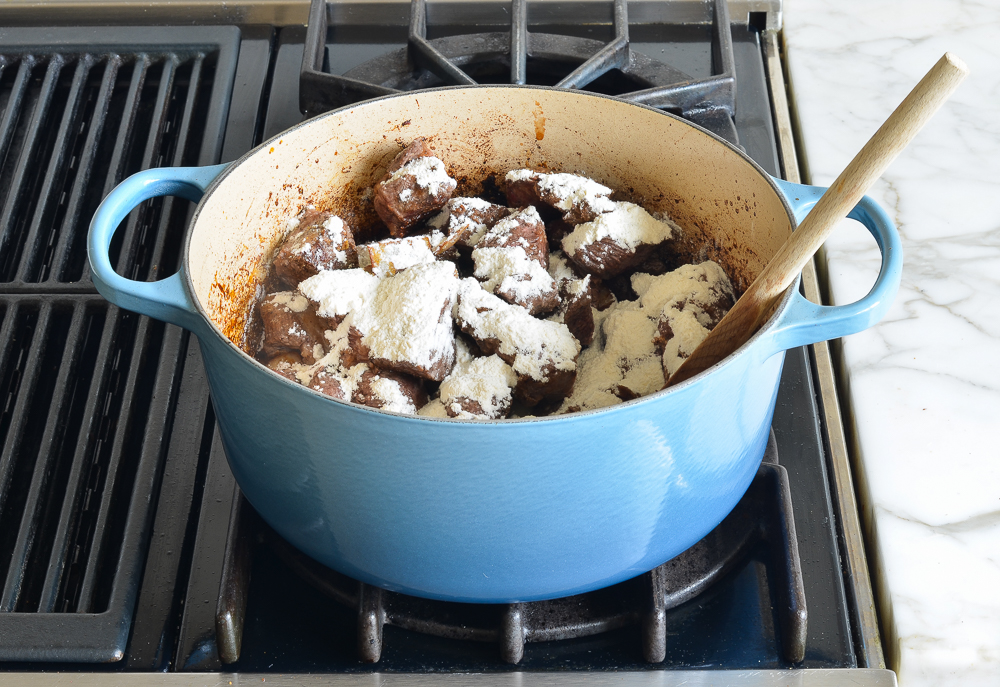
Stir until the flour is dissolved.
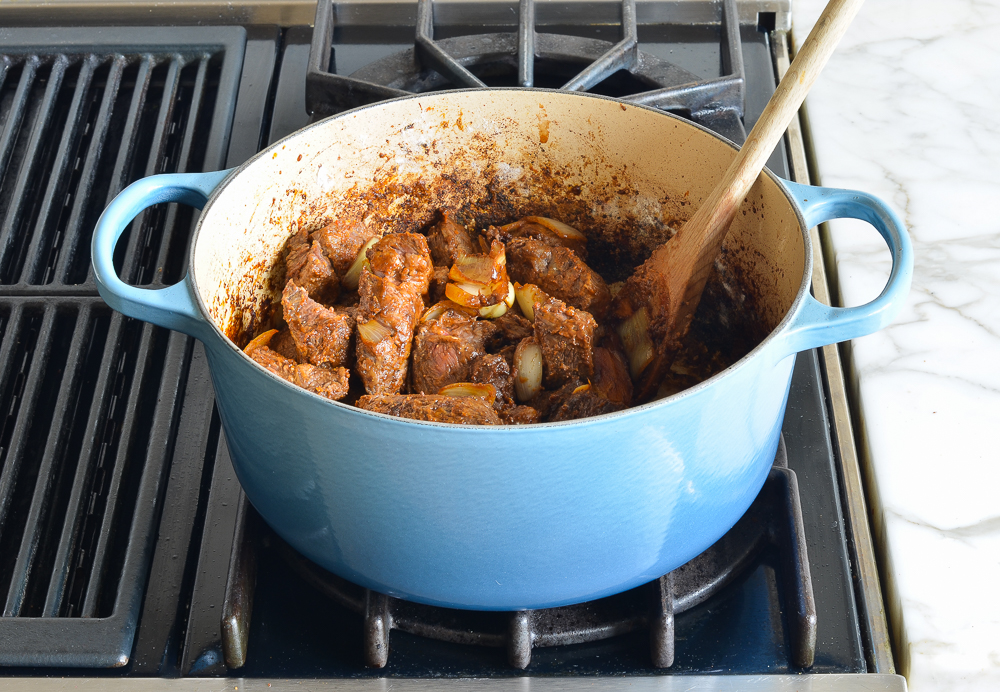
Add the wine, broth, water, thyme, bay leaves, and sugar.
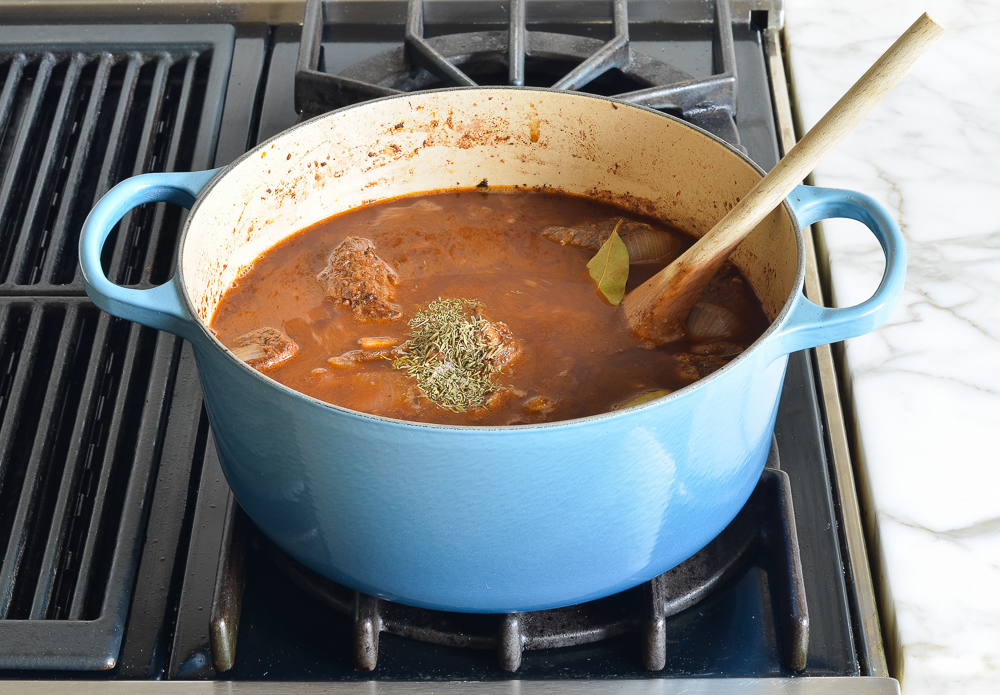
Bring to a boil, then cover and braise in the oven for 2 hours. (If you don’t have a Dutch oven or prefer to cook the stew on the stovetop, that works, too! The timing will be the same—just keep it on the lowest heat setting and stir occasionally to prevent sticking.)
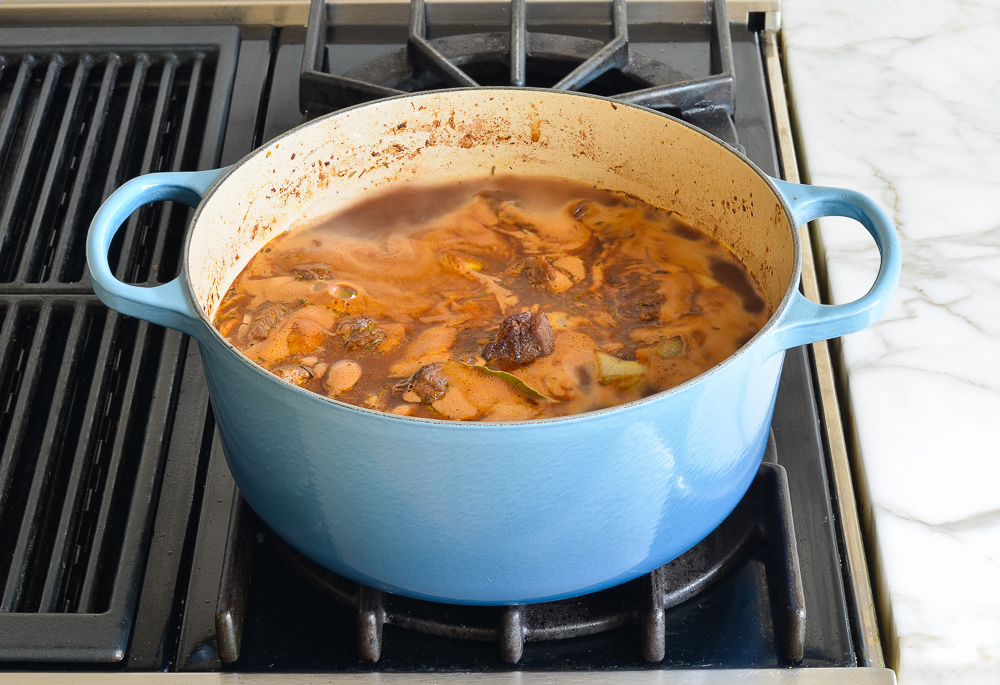
After 2 hours, add the carrots and potatoes.

Return to the oven and continue cooking for one hour, or until the meat is fork-tender, the broth is thickened, and the carrots and potatoes are tender. (Note: The broth won’t thicken until the very end of cooking. If you’d like to thicken it further after it’s done, see the FAQ below for tips.)
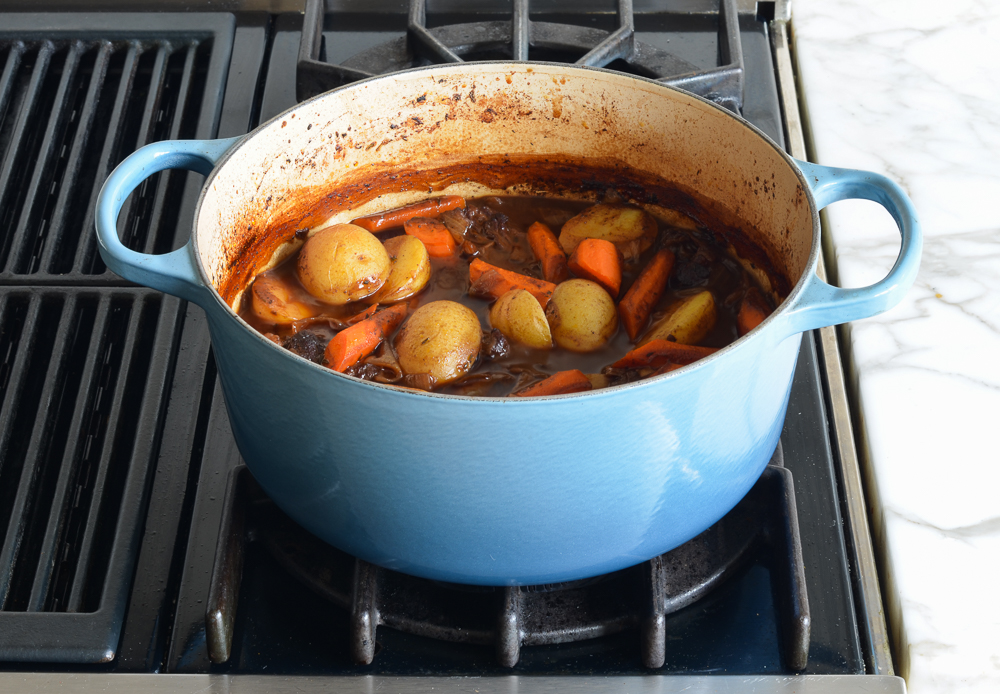
Frequently Asked Questions
Yes, you’ll just need to follow the initial steps of searing the meat and sautéing the onions and garlic as instructed. Once you’re ready to add the water, wine, and broth, transfer everything to the slow cooker. You can add the carrots and potatoes along with the meat at this point (no need to wait). The cook time should be 4 to 5 hours.
The stew naturally thickens as it cooks, but it won’t reach its final consistency until the very end of cooking. But if you’d like to thicken it further, you can use a beurre manié, which is a mixture of softened butter and flour. To make it, simply knead equal parts soft butter and flour (about 2 tablespoons each) into a smooth paste. Gradually stir small amounts of the beurre manié into the simmering stew, allowing it to dissolve fully before adding more. This technique adds richness and helps thicken the stew to a velvety consistency without affecting the flavor.
Make-Ahead/Freezing Instructions
Simply prepare the stew as directed, then cool it to room temperature before refrigerating. It can be stored in the fridge for up to 3 days. Reheat on the stovetop over medium-low heat until hot. If you want to freeze the stew, transfer it to an airtight container once it has cooled. It can be frozen for up to 3 months. To serve, thaw the stew overnight in the refrigerator and reheat on the stovetop.
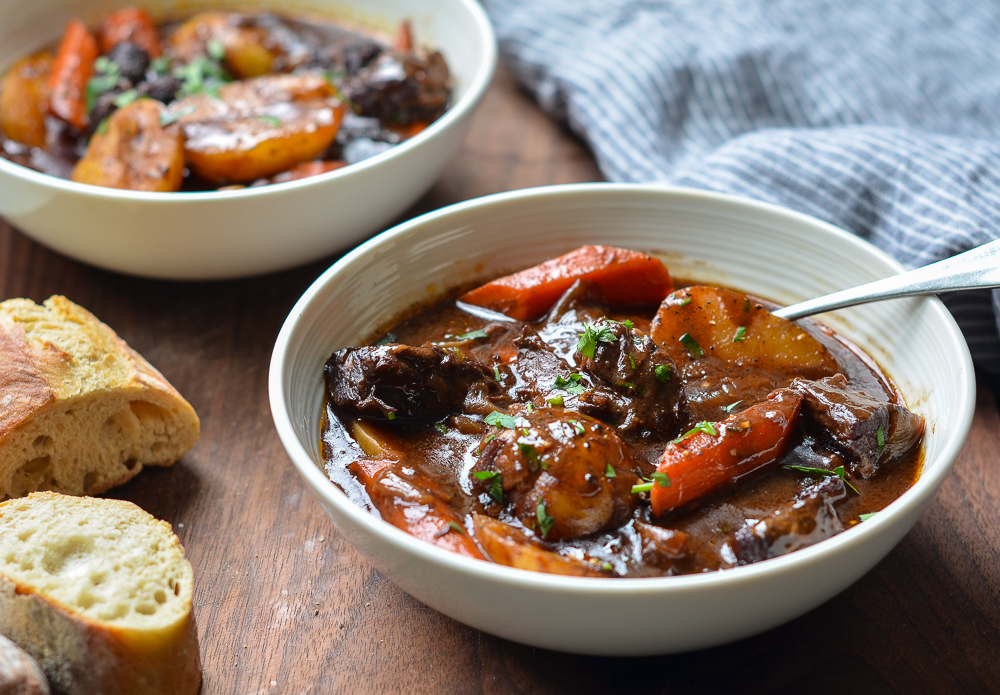
Video Tutorial
You May Also Like
Beef Stew
This classic French beef stew is the ultimate comfort food. Slow-cooked in a rich wine-based broth, the meat becomes meltingly tender and enveloped in a deeply flavorful sauce—perfect for chilly nights.
Ingredients
- 3 pounds boneless beef chuck (well-marbled), cut into 1½-inch pieces
- 2 teaspoons salt
- 1 teaspoon freshly ground black pepper
- 3 tablespoons olive oil
- 2 medium yellow onions, cut into 1-inch chunks
- 7 cloves garlic, peeled and smashed
- 2 tablespoons balsamic vinegar
- 1½ tablespoons tomato paste
- ¼ cup all-purpose flour
- 2 cups dry red wine
- 2 cups beef broth
- 2 cups water
- 1 bay leaf
- ½ teaspoon dried thyme
- 1½ teaspoons sugar
- 4 large carrots, peeled and cut into 1-inch chunks on a diagonal
- 1 pound small white boiling potatoes (baby yukons), cut in half
- Fresh chopped parsley, for serving (optional)
Instructions
- Preheat the oven to 325°F and set a rack in the lower middle position.
- Pat the beef dry and season with the salt and pepper. In a large Dutch oven or heavy soup pot, heat 1 tablespoon of the olive oil over medium-high heat until hot and shimmering. Brown the meat in 3 batches, turning with tongs, for about 5 minutes per batch; add one tablespoon more oil for each batch. (To sear the meat properly, do not crowd the pan and let the meat develop a nice brown crust before turning with tongs.) Transfer the meat to a large plate and set aside.
- Add the onions, garlic and balsamic vinegar; cook, stirring with a wooden spoon and scraping the brown bits from bottom of the pan, for about 5 minutes. Add the tomato paste and cook for a minute more. Add the beef with its juices back to the pan and sprinkle with the flour. Stir with wooden spoon until the flour is dissolved, 1 to 2 minutes. Add the wine, beef broth, water, bay leaf, thyme, and sugar. Stir with a wooden spoon to loosen any brown bits from the bottom of the pan and bring to a boil. Cover the pot with a lid, transfer to the preheated oven, and braise for 2 hours.
- Remove the pot from the oven and add the carrots and potatoes. Cover and place back in oven for about an hour more, or until the vegetables are cooked, the broth is thickened, and the meat is tender. Fish out the bay leaf and discard, then taste and adjust seasoning, if necessary. Serve the stew warm -- or let it come to room temperature and then store in the refrigerator overnight or until ready to serve. This stew improves in flavor if made at least 1 day ahead. Reheat, covered, over medium heat. Garnish with fresh parsley, if desired.
- Note: If you don’t have a Dutch oven or covered pot that is appropriate for the oven, the stew can be cooked on the stove. The timing will be the same and it should be cooked over the lowest setting.
- Make-Ahead/Freezer-Friendly Instructions: Simply prepare the stew as directed, then cool it to room temperature before refrigerating. It can be stored in the fridge for up to 3 days. Reheat on the stovetop over medium-low heat until hot. If you want to freeze the stew, transfer it to an airtight container once it has cooled. It can be frozen for up to 3 months. To serve, thaw the stew overnight in the refrigerator and reheat on the stovetop.
Pair with
Nutrition Information
Powered by ![]()
- Per serving (6 servings)
- Calories: 539
- Fat: 18g
- Saturated fat: 6g
- Carbohydrates: 32g
- Sugar: 8g
- Fiber: 4g
- Protein: 54g
- Sodium: 1189mg
- Cholesterol: 143mg
This website is written and produced for informational purposes only. I am not a certified nutritionist and the nutritional data on this site has not been evaluated or approved by a nutritionist or the Food and Drug Administration. Nutritional information is offered as a courtesy and should not be construed as a guarantee. The data is calculated through an online nutritional calculator, Edamam.com. Although I do my best to provide accurate nutritional information, these figures should be considered estimates only. Varying factors such as product types or brands purchased, natural fluctuations in fresh produce, and the way ingredients are processed change the effective nutritional information in any given recipe. Furthermore, different online calculators provide different results depending on their own nutrition fact sources and algorithms. To obtain the most accurate nutritional information in a given recipe, you should calculate the nutritional information with the actual ingredients used in your recipe, using your preferred nutrition calculator.


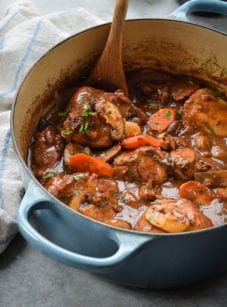
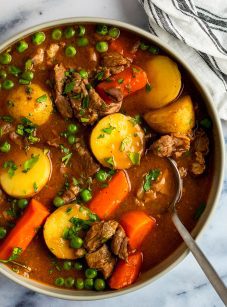

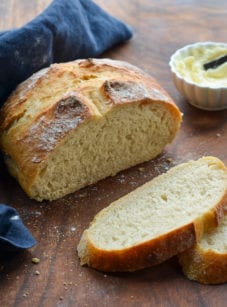
Great stew recipe. I used stew beef from the 1/4 cow we purchased, so I wasn’t worried it would be tough.
I put my carrots in after 1 hour because they were very large and thick, then added potatoes hour later.
I did use the 2 tbs butter and 2 tbsp flour mashed together to thicken the gravy at the end.
Enough leftovers for second dinner during the week.Definitely will make a again.
I keep making this over and over when my son comes over for Sunday dinner. Excellent. Thank you!!!
I’m excited to make this today for dinner for tomorrow. As I’ve never made a pot roast is this considered one? Your recipes are my go to favorites. Thanks
Hi Barbara, A pot roast is very similar to this, but the beef is left whole instead of cut into chunks. Hope you enjoy the stew!
Rarely do I write reviews…mostly I think most of the recipes I try are just not that great…this was the exception. First I thought the instructions were spot on..everything lined up and took the recommended amount of time. I loved the way this dish tasted, hearty with perfectly done veggies that were not mushy. I wanted a bit more gravy and I kept adding salt after it was done but overall it’s a 5 star recipe for sure!
Hi—I just checked with my butcher—as expected he has a ‘beef shoulder roll’ which he says is same thing as chuck roast. He also has chuck meat well marbled already cubed. Thoughts? This is all a foreign language to me!
Hi Kay, I’d go with the cubed, well-marbled chuck meat. The beef shoulder roll may not have enough marbling. Hope that helps!
It’s likely that one your thousands of fans 😊 already asked this: Does cooking time change if doubled?
Also, I’m afraid of buying wrong meat as I’ve never been successful with stew meats. Are there other names for the chuck roast if my butcher tries to convince me of a different cut? Hope this makes sense. Thanks as always Jenn!
Hi Kay, See my answer above re. the meat. The cook time may be a bit longer if doubled. It’s hard to say how much, so just keep an eye on it and check for tenderness.
I’m excited to make this! Busy week: Wondering if this could be adapted to slow cooker (after browning, etc).
Hi Adrie, Yes that’s fine to transfer everything to a slow cooker after browning.
I have been following this recipe since around 2017 I think. My whole family loves this recipe. Thank you for sharing this masterpiece. Love from Australia.
Hi! I’m making this tonight for dinner, I like a thick stew as opposed to semi soupy so I was wondering if I can flour the cubed chuck before browning to add some thickness or will that make it too thick? Also, would a splash of ruby port in addition to the red wine ruin the flavor? Thanks!
Instead of flouring the beef, I’d wait until the end of the cooking time and if it’s not thick enough for your liking, mash 2 tablespoons of softened butter with 2 tablespoons of flour; whisk it into the simmering stew little by little until the stew is thickened to your liking. And adding a splash of port would be fine. Hope that helps and that you enjoy!
A winner! This is my new go-to beef stew recipe. Reminiscent of beef bourguignon but half the labor!